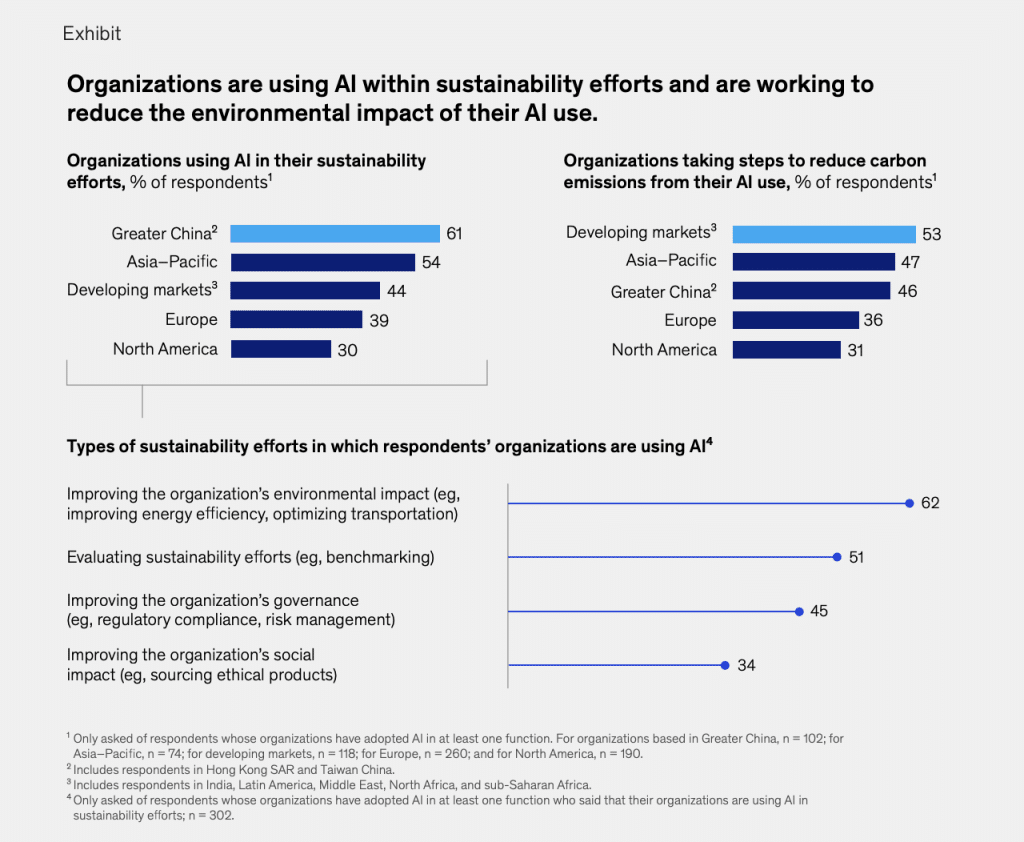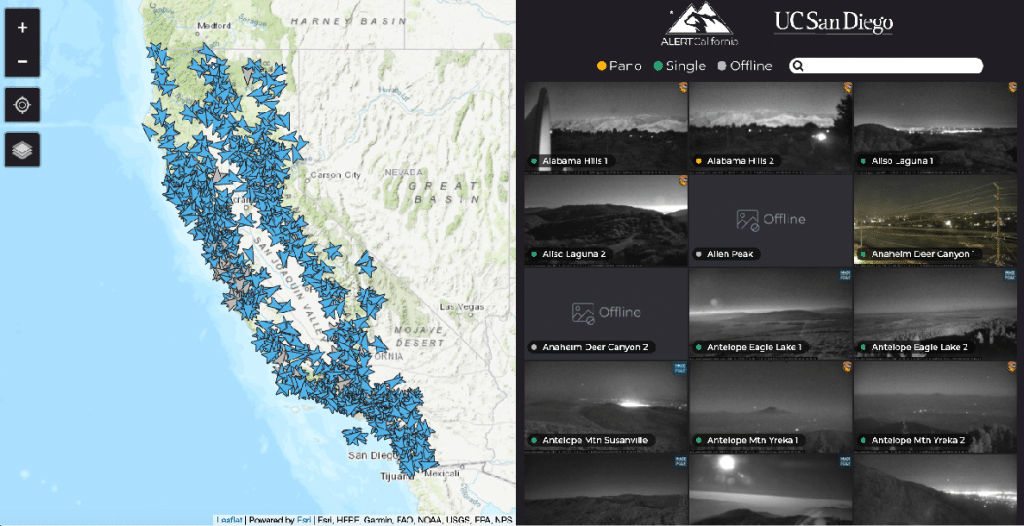In an era where sustainability is a necessity, artificial intelligence (AI) is becoming a key tool in shaping sustainability strategies across various sectors. It plays a multifaceted role, from reducing carbon footprints to enhancing public safety.
A 2022 survey by McKinsey & Company shows a trend: organizations are increasingly using AI in their sustainability strategy. The survey offers a detailed look at global AI use for sustainability, with adoption varying by region.
But the data is just part of the story.
This article explores AI’s potential for sustainability – supported by data – and highlights specific AI real-life applications, such as Google’s Project Contrails in aviation and ALERTCalifornia in natural disaster management.
AI’s Role in Shaping Sustainability Strategy
The integration of AI into sustainability initiatives is more than a buzzword – it’s a growing trend with real impact. Organizations are recognizing the tech’s potential to drive business objectives and contribute to sustainable practices.
Survey Findings on Sustainability Strategy and AI
A 2022 survey by McKinsey & Company highlights how organizations are using AI in their sustainability strategy. The survey shows that many organizations are using AI to boost their sustainability efforts and are also working to lessen the environmental impact of their AI operations.

According to the survey, 43% of respondents from organizations using AI said they are using AI in their sustainability strategy. This varied by region:
- Greater China (including Hong Kong SAR and Taiwan China): 61% of organizations
- Asia-Pacific: 54%
- Developing markets (India, Latin America, Middle East, North Africa, and sub-Saharan Africa): 44%
- Europe: 39%
- North America: 30%
Furthermore, 40% of respondents said their organizations are working to reduce the environmental impact of their AI use by minimizing the energy used to train and run AI models. This also varied by region:
- Developing markets: 53% of organizations
- Asia-Pacific: 47%
- Greater China: 46%
- Europe: 36%
- North America: 31%
The survey also explored the types of sustainability efforts involving AI:
- 62% use AI to better their environmental impact, like energy efficiency and waste reduction;
- 51% use AI to evaluate sustainability efforts, such as benchmarking;
- 45% use AI for governance, including compliance and risk management;
- 34% use AI for social impact, like ethical sourcing.
High Performers in AI
Organizations that invested more in AI were 1.4 times more likely to have AI-enabled sustainability efforts. These top performers were also keen on reducing AI-related emissions.
Interestingly, organizations in Greater China, Asia-Pacific, and developing markets engaged in these efforts more often.
On the other hand, those in North America were the least likely to do so.
By using AI, organizations are not just improving their sustainability strategies. They are also setting a standard for responsible AI use, contributing to a more sustainable and fair future.
Google’s Project Contrails: AI’s Sustainable Strategy for Aviation’s Climate Impact
Building on the growing trend of integrating AI into sustainability strategy, it’s crucial to explore specific examples that demonstrate this technology’s transformative potential.
One key example is Google’s Project Contrails, which aims to reduce aviation’s climate impact. This project serves as a compelling case study of how AI can be strategically employed to make significant strides in sustainability, particularly in sectors with substantial environmental footprints like aviation.
Contrails and Climate Impact
Contrails are lines of cloud that form behind jets, which happen when water vapor and soot from engines freeze into ice. These lines can turn into contrail cirrus clouds, which have a big impact on the environment.
To form contrails, three things must be present: water vapor, cool air, and tiny particles. They’re more likely to appear in cold, moist air, usually at high altitudes.
Contrails are not harmless. They trap heat in the atmosphere, contributing to climate change. A study found that contrail cirrus clouds have the most warming effect in aviation, even surpassing the impact of CO2 emissions from planes (Lee, D.S. et al., 2021).
Overview of Google’s Project Contrails
Google’s Project Contrails aims to lessen aviation’s climate impact by using AI to predict contrail formation. This helps airlines avoid creating these warming trails, aligning with their sustainability strategy.
The AI model combines weather, satellite, and flight data, predicting when and where contrails are likely to form. Engineers trained the model on tens of thousands of satellite images to detect contrails.
In fact, the model can identify these contrails in satellite imagery in just 30 minutes.
Real-World Testing with American Airlines
In a test with American Airlines, pilots used AI predictions to avoid contrail-forming routes. The results showed a 54% reduction in contrails, with fuel usage increasing by only 2%. Since only a small fraction of flights would need to be adjusted to avoid the majority of contrail warming, the fuel increase across an airline’s fleet could be as low as +0.3%. This makes it a cost-effective part of an airline’s sustainability strategy.
Ultimately, the extra fuel burned is more than offset by the reduction in contrail warming, making it a net positive for the climate. The project’s success suggests that contrail avoidance could become standard in aviation, highlighting AI’s role in climate change mitigation.
ALERTCalifornia: AI-Enabled Public Safety
As we’ve seen, AI is increasingly becoming a cornerstone in sustainability strategies across various sectors, from general business practices to specialized fields like aviation. Google’s Project Contrails shows how AI can mitigate aviation’s climate impact. Another key example is ALERTCalifornia, which focuses on natural disasters, especially wildfires.
Based at the University of California San Diego, ALERTCalifornia aims to understand natural disasters, looking at the short and long-term impacts on people and the environment. The program informs better disaster preparedness and response.
Cutting-Edge Tech in Sustainability Strategy
The initiative uses advanced technology to study changing disaster patterns. Developed by engineers at UC San Diego, the platform uses AI from DigitalPath, a California-based company. This technology supports data-driven decisions for preparing, responding to, and recovering from natural disasters, aligning with broader sustainability strategy goals.
ALERTCalifornia has deployed over 1,000 high-definition cameras across the state. These cameras can rotate 360 degrees and have near-infrared night vision capabilities, providing real-time monitoring of wildfires and other disasters. The cameras can perform 360-degree sweeps approximately every two minutes and have a viewing range of up to 60 miles during the day and 120 miles at night.

The real-time monitoring has significantly improved situational awareness for first responders, allowing for quicker decision-making and thus reducing the time it takes for fire ground commanders to react from 20-30 minutes to mere seconds.
Tony Mecham, CAL FIRE San Diego County Unit Chief, said:
“It used to take 20 to 30 minutes for our fire ground commanders to get to fires and make decisions, and now, with the cameras, we are reacting within seconds of the first report… It’s making a difference. I can’t even put into words how important those first few minutes are.”
The program’s success has broader implications for public safety and disaster management, serving as a model for other states and countries. It also adds to research on how to prepare for and respond to wildfires. The collected data is available to companies and researchers, which could lead to new AI applications for environmental study.
By integrating AI into its operations, ALERTCalifornia is not only enhancing wildfire response but also contributing to a more comprehensive public safety and disaster management strategy, which is a key component of a long-term sustainability strategy.
The Bottom Line
AI is not just a tech advancement; it’s a catalyst for change in sustainability strategy. It’s invaluable in tackling pressing challenges from aviation to public safety.
Google’s Project Contrails and ALERTCalifornia are prime examples. They show how AI can be used to make significant strides in sustainability. These are not isolated cases but part of a larger trend, with AI becoming central in sustainability strategies. The data from these initiatives is also opening new research avenues, which could lead to new AI applications for environmental study.
In summary, integrating AI into sustainability strategy is an impactful trend. It sets the standard for responsible AI use, contributing to a more sustainable and fair future for all.










